Spatiotemporal Variation in the Meteorological Drought Comprehensive Index in the Beijing–Tianjin–Hebei Region during 1961–2023
Abstract
:1. Introduction
2. Materials and Methods
2.1. Study Area
2.2. Data
2.3. Methods
2.3.1. Meteorological Drought Comprehensive Index
2.3.2. Empirical Orthogonal Function on the MCI
2.3.3. Wavelet Coherence between the MCI and Atmospheric Circulation/SST Indices
3. Results
3.1. Temporal Variations in MCI in the Beijing–Tianjin–Hebei Region
3.2. Spatial Patterns of the MCI in the Beijing–Tianjin–Hebei Region
3.3. Comparison of the MCI Characteristics between 1961–1990 and 1991–2023
3.4. Different Return Periods of the MCI in the Beijing–Tianjin–Hebei Region
4. Discussion
5. Conclusions
Author Contributions
Funding
Data Availability Statement
Conflicts of Interest
References
- Werner, C.; Meredith, L.K.; Ladd, S.N.; Ingrisch, J.; Kübert, A.; van Haren, J.; Bahn, M.; Bailey, K.; Bamberger, I.; Beyer, M. Ecosystem fluxes during drought and recovery in an experimental forest. Science 2022, 374, 1514–1518. [Google Scholar] [CrossRef]
- Eisenhauer, N.; Weigelt, A. Ecosystem effects of environmental extremes. Science 2022, 374, 1442–1443. [Google Scholar] [CrossRef] [PubMed]
- Chen, X.D.; Tian, F.Y.; Su, Y. How did the late 1920s drought affect northern Chinese society? Weather. Clim. Extreme 2022, 36, 100451. [Google Scholar] [CrossRef]
- Sugg, M.; Runkle, J.; Leeper, R.; Bagli, H.; Golden, A.; Handwerger, L.H.; Magee, T.; Moreno, C.; Reed-Kelly, R.; Taylor, M. A scoping review of drought impacts on health and society in North America. Clim. Chang. 2020, 162, 1177–1195. [Google Scholar] [CrossRef]
- Bai, M.X.; Zheng, J.Y.; Hao, Z.X.; Zhang, X.Z.; Zeng, G. Hydroclimate patterns over the Northern Hemisphere when megadroughts occurred in North China during the last millennium. Clim. Chang. 2019, 157, 365–385. [Google Scholar] [CrossRef]
- Dai, A.G. Increasing drought under global warming in observations and models. Nat. Clim. Chang. 2013, 3, 52–58. [Google Scholar] [CrossRef]
- Dai, A.G. Characteristics and trends in various forms of the Palmer Drought Severity Index during 1900–2008. J. Geophys. Res. Atmos. 2011, 116, D12115. [Google Scholar] [CrossRef]
- Dai, A.G.; Lamb, P.J.; Trenberth, K.E.; Hulme, M.; Jones, P.D.; Xie, P.P. The recent Sahel drought is real. Int. J. Climatol. 2004, 24, 1323–1331. [Google Scholar] [CrossRef]
- Spinoni, J.; Naumann, G.; Carrao, H.; Barbosa, P.; Vogt, J. World drought frequency, duration, and severity for 1951–2010. Int. J. Climatol. 2014, 34, 2792–2804. [Google Scholar] [CrossRef]
- van der Schrier, G.; Barichivich, J.; Briffa, K.R.; Jones, P.D. A scPDSI-based global dataset of dry and wet spells for 1901–2009. J. Geophys. Res. Atmos. 2013, 118, 4025–4048. [Google Scholar] [CrossRef]
- Donat, M.G.; Alexander, L.V.; Yang, H.; Durre, I.; Vose, R.; Dunn, R.J.H.; Willett, K.M.; Aguilar, E.; Brunet, M.; Caesar, J.; et al. Updated analyses of temperature and precipitation extreme indices since the beginning of the twentieth century: The HadEX2 dataset. J. Geophys. Res. Atmos. 2013, 118, 2098–2118. [Google Scholar] [CrossRef]
- Frich, P.; Alexander, L.V.; Della-Marta, P.; Gleason, B.; Haylock, M.; Tank, A.; Peterson, T. Observed coherent changes in climatic extremes during the second half of the twentieth century. Clim. Res. 2002, 19, 193–212. [Google Scholar] [CrossRef]
- Alexander, L.V.; Zhang, X.; Peterson, T.C.; Caesar, J.; Gleason, B.; Tank, A.M.G.K.; Haylock, M.; Collins, D.; Trewin, B.; Rahimzadeh, F.; et al. Global observed changes in daily climate extremes of temperature and precipitation. J. Geophys. Res. Atmos. 2006, 111, D05109. [Google Scholar] [CrossRef]
- Giorgi, F.; Im, E.S.; Coppola, E.; Diffenbaugh, N.S.; Gao, X.J.; Mariotti, L.; Shi, Y. Higher hydroclimatic intensity with global warming. J. Clim. 2011, 24, 5309–5324. [Google Scholar] [CrossRef]
- Wang, X.X.; Jiang, D.B.; Lang, X.M. Future extreme climate changes linked to global warming intensity. Sci. Bull. 2017, 62, 1673–1680. [Google Scholar] [CrossRef]
- Society, A.M. Meteorological drought-policy statement. B. Am. Meteorol. Soc. 1997, 78, 55–94. [Google Scholar]
- Wilhite, D.A. Drought and Water Crises: Science, Technology, and Management Issues; CRC Press: Boca Raton, FL, USA, 2005. [Google Scholar]
- Han, Z.H.; Liu, X.G.; Hao, K.; Yu, N.; Liu, Y.W.; Yang, Q.L. Drought evolution characteristics and trend prediction in Inner Mongolia based on standardized precipitation index. J. Irrig. Drain. Eng. 2017, 35, 430–439. (In Chinese) [Google Scholar]
- Sobral, B.S.; de Oliveira-Júnior, J.F.; de Gois, G.; Pereira, E.R.; Terassi, P.M.D.; Muniz, J.G.R.; Lyra, G.B.; Zeri, M. Drought characterization for the state of Rio de Janeiro based on the annual SPI index: Trends, statistical tests and its relation with ENSO. Atmos. Res. 2019, 220, 141–154. [Google Scholar] [CrossRef]
- Yang, Y.; Gan, T.Y.; Tan, X. Spatiotemporal changes of drought characteristics and their dynamic drivers in Canada. Atmos. Res. 2020, 232, 104695. [Google Scholar] [CrossRef]
- Zhang, X.T.; Pan, X.B.; Xu, L.; Wei, P.; Yin, Z.W.; Shao, C.X. Analysis of spatio-temporal distribution of drought characteristics based on SPEI in Inner Mongolia during 1960–2015. Trans. Chin. Soc. Agricul. Eng. 2017, 33, 190–199. (In Chinese) [Google Scholar]
- Zhang, J.; Sun, F.; Lai, W.; Lim, W.H.; Liu, W.B.; Wang, T.T.; Wang, P.T. Attributing changes in future extreme droughts based on PDSI in China. J. Hydrol. 2019, 573, 607–615. [Google Scholar] [CrossRef]
- Wang, C.L.; Guo, J.; Xue, L.F.; Ding, L.J. An Improved Comprehensive Meteorological Drought Index CI_(new) and Its Applicability Analysis. Chin. J. Agrometeorol. 2011, 32, 621–626. (In Chinese) [Google Scholar]
- GB/T 20481-2017; Grades of Meteorological Drought. Standards Press of China: Beijing, China, 2017.
- Hayes, M.J.; Svoboda, M.D.; Wilhite, D.A.; Vanyarkho, O.V. Monitoring the 1996 drought using the standardized precipitation index. Bull. Am. Meteorol. Soc. 1999, 80, 429–438. [Google Scholar] [CrossRef]
- Vicente-Serrano, S.M.; Beguería, S.; López-Moreno, J.I. A multiscalar drought index sensitive to global warming: The standardized precipitation evapotranspiration index. J. Clim. 2010, 23, 1696–1718. [Google Scholar] [CrossRef]
- Su, H.X.; Li, G.Q. Low-frequency drought variability based on SPEI in association with climate indices in Beijing. Acta Ecol. Sin. 2012, 32, 5467–5475. (In Chinese) [Google Scholar]
- Fan, J.; Lian, Y.N.; Zhao, H. Review of the research progress in Beijing-Tianjin-Hebei region since 1980. Acta Geogr. Sin. 2022, 77, 1299–1319. (In Chinese) [Google Scholar]
- Fang, C.L. Theoretical foundation and patterns of coordinated development of the Beijing-Tianjin-Hebei Urban Agglomeration. Prog. Geog. 2017, 36, 15–24. (In Chinese) [Google Scholar]
- Zheng, J.Y.; Wu, M.W.; Ge, Q.S.; Hao, Z.X.; Zhang, X.Z. Observed, Reconstructed, and Simulated Decadal Variability of Summer Precipitation over Eastern China. J. Meteorol. Res. 2017, 31, 49–61. [Google Scholar] [CrossRef]
- Ding, Y.H.; Wang, Z.Y.; Sun, Y. Inter-decadal variation of the summer precipitation in East China and its association with decreasing Asian summer monsoon. Part I: Observed evidences. Int. J. Climatol. 2008, 28, 1139–1161. [Google Scholar] [CrossRef]
- Huang, R.H.; Liu, Y.; Huangfu, J.L.; Feng, T. Characteristics and internal dynamical causes of the interdecadal variability of East Asian winter monsoon near the late 1990s. Chin. J. Atmos. Sci. 2014, 38, 627–644. (In Chinese) [Google Scholar]
- Ding, Y.H.; Si, D.; Liu, Y.J.; Wang, Z.Y.; Li, Y.; Zhao, L.; Song, Y.F. On the characteristics, driving forces and interdecadal variability of the East Asian summer monsoon. Chin. J. Atmos. Sci. 2018, 42, 533–558. (In Chinese) [Google Scholar]
- Zhou, L.T.; Huang, R.H. Research on the characteristics of interdecadal variability of summer climate in China and its possible cause. Clim. Environ. Res. 2003, 8, 274–290. (In Chinese) [Google Scholar]
- Ding, Y.H.; Zhang, L. Intercomparison of the time for climate abrupt change between the Tibetan Plateau and other regions in China. Chin. J. Atmos. Sci. 2008, 32, 794–805. (In Chinese) [Google Scholar]
- Yang, X.Q.; Xie, Q.; Zhu, Y.M.; Sun, X.G.; Guo, Y.J. Decadal-to-interdecadal variability of precipitation in North China and associated atmospheric and oceanic anomaly patterns. Chin. J. Geophys. 2005, 48, 789–797. (In Chinese) [Google Scholar]
- Zhang, C.J.; Li, D.L.; Wang, X.P. Study of precipitation variability in last 100 years and trend prediction in Northeast Asia in future 10–15 years. Plat. Meteorol. 2004, 23, 919–929. (In Chinese) [Google Scholar]
- Ding, Y.H.; Sun, Y.; Wang, Z.Y.; Zhu, Y.X.; Song, Y.F. Inter-decadal variation of the summer precipitation in China and its association with decreasing Asian summer monsoon Part II: Possible causes. Int. J. Climatol. 2009, 29, 1926–1944. [Google Scholar] [CrossRef]
- Zhang, Z.Y.; Xu, X.D.; Qiao, L.; Gong, D.Y.; Kim, S.J.; Wang, Y.J.; Mao, R. Numerical simulations of the effects of regional topography on haze pollution in Beijing. Sci. Rep. 2018, 8, 5504. [Google Scholar] [CrossRef]
- Chow, F.K.; Yu, K.A.; Young, A.; James, E.; Grell, G.A.; Csiszar, I.; Tsidulko, M.; Freitas, S.; Pereira, G.; Giglio, L. High-Resolution Smoke Forecasting for the 2018 Camp Fire in California. Bull. Am. Meteorol. Soc. 2022, 103, 1531–1552. [Google Scholar] [CrossRef]
- Xu, R.B.; Ye, T.T.; Yue, X.; Yang, Z.Y.; Yu, W.H.; Zhang, Y.W.; Bell, M.L.; Morawska, L.; Yu, P.; Zhang, Y.X. Global population exposure to landscape fire air pollution from 2000 to 2019. Nature 2023, 621, 521–529. [Google Scholar] [CrossRef]
- Zhao, H.Y.; Zhang, Q.; Gao, G.; Lu, E. Characteristic analysis of agricultural drought disaster in China during 1951–2007. J. Nat. Disasters 2010, 19, 201–206. (In Chinese) [Google Scholar]
- Hu, Y.N.; Li, K.; Xu, Y.L. Characteristic Analysis of Agricultural Meteorological Disasters and Risk Assessment of the Crop Loss in North China Plain during 1951-2010. Chin. J. Agrometeorol. 2013, 34, 197–203. [Google Scholar]
- Available online: https://www.mem.gov.cn/xw/yjglbgzdt/202310/t20231008_465002.shtml (accessed on 8 October 2023).
- Zhang, J.; Sun, F.B.; Liu, W.B.; Liu, J.H.; Wang, H. Spatio-temporal patterns of drought evolution over the Beijing-Tianjin-Hebei region, China. J. Geogra. Sci. 2019, 29, 863–876. [Google Scholar] [CrossRef]
- Kuang, W.H.; Chen, L.J.; Liu, J.Y.; Xiang, W.N.; Chi, W.F.; Lu, D.S.; Yang, T.R.; Pan, T.; Liu, A.L. Remote sensing-based artificial surface cover classification in Asia and spatial pattern analysis. Sci. China Earth Sci. 2016, 59, 1720–1737. [Google Scholar] [CrossRef]
- Available online: http://cmdp.ncc-cma.net/Monitoring/cn_index_130.php (accessed on 10 July 2023).
- McKee, T.B.; Doesken, N.J.; Doesken, J. The relationship of drought frequency and duration to time scale. In Proceedings of the Eighth Conference on Applied Climatology. American Meteorological Society, Anaheim, CA, USA, 17–22 January 1993; pp. 179–184. [Google Scholar]
- Lorenz, E.N. Seasonal and irregular variations of the Northern Hemisphere sea-level pressure profile. J. Meteorol. 1951, 8, 52–59. [Google Scholar] [CrossRef]
- North, G.R.; Bell, T.L.; Cahalan, R.F.; Moeng, F.J. Sampling errors in the estimation of Empirical Orthogonal Functions. Mon. Weather Rev. 1982, 110, 699–706. [Google Scholar] [CrossRef]
- Torrence, C.; Compo, G.P. A practical guide to wavelet analysis. Bull. Am. Meteorol. Soc. 1998, 79, 61–78. [Google Scholar] [CrossRef]
- Hope, A.C.A. A simplified Monte Carlo significance test procedure. J. Roy. Stat. Soc. 1968, 30, 582–598. [Google Scholar] [CrossRef]
- Huang, R.H.; Xu, Y.H.; Zhou, L.T. The interdecadal variations of summer precipitation in China and the drought trend in North China. Plat. Meteorol. 1999, 18, 465–476. [Google Scholar]
- Hao, L.S.; Ding, Y.H.; Kang, W.Y. Relationship between changes in Indian Ocean SST and reduced summer precipitation in North China. Clim. Chang. Res. Bull. 2012, 1, 13–31. (In Chinese) [Google Scholar]
- Qian, C.; Zhou, T.J. Multidecadal variability of North China aridity and its relationship to PDO during 1900–2010. J. Clim. 2014, 27, 1210–1222. [Google Scholar] [CrossRef]

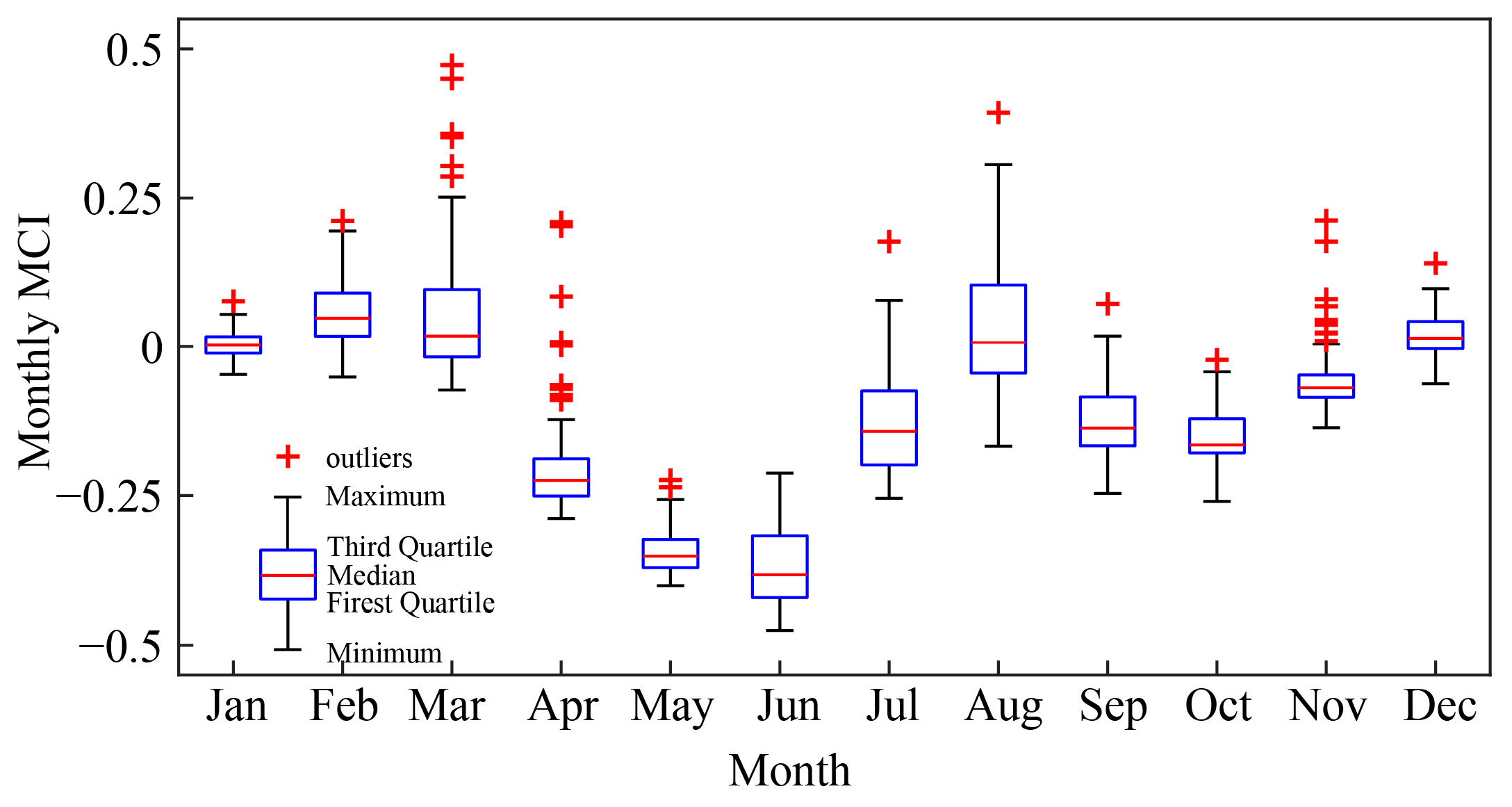
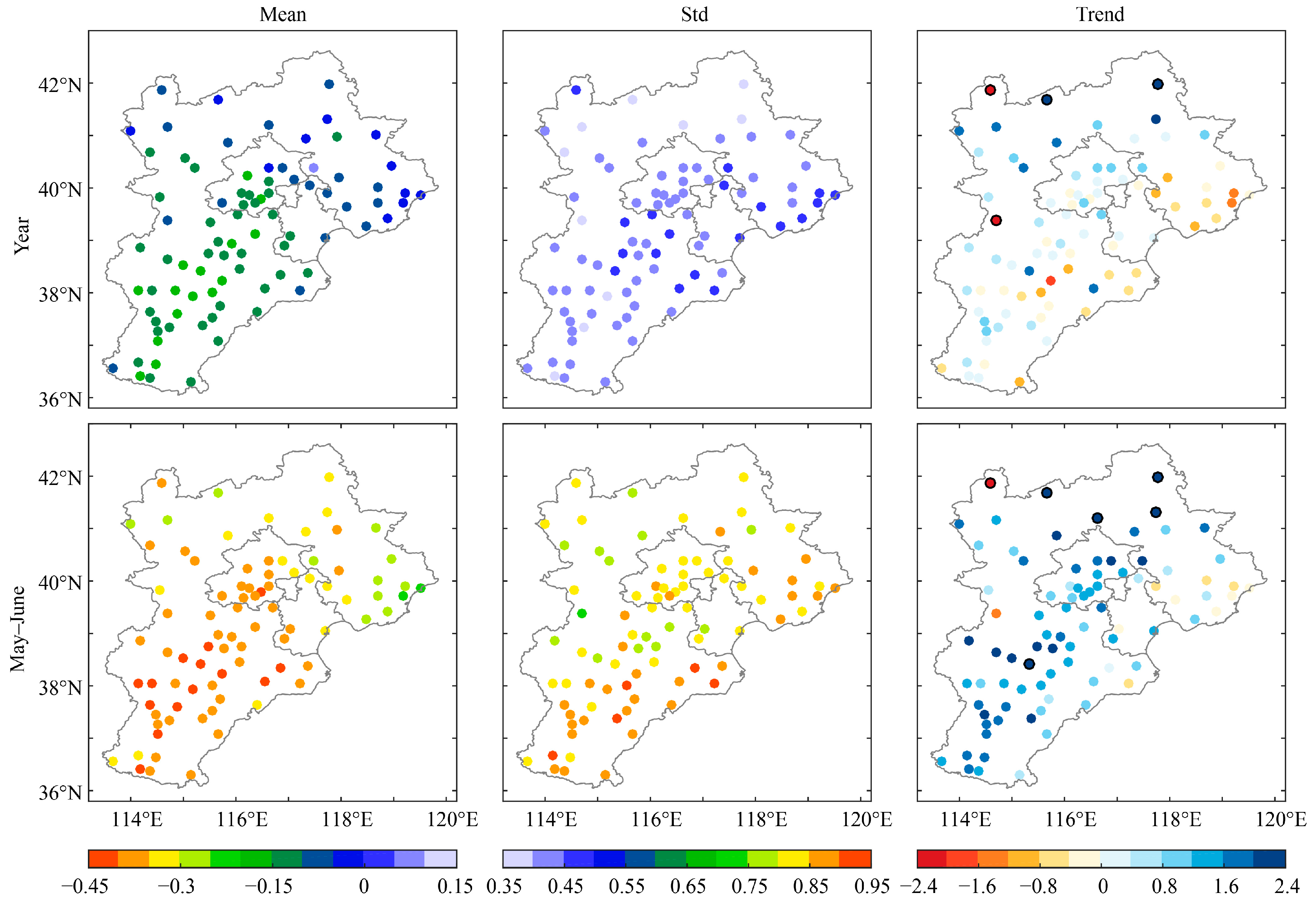

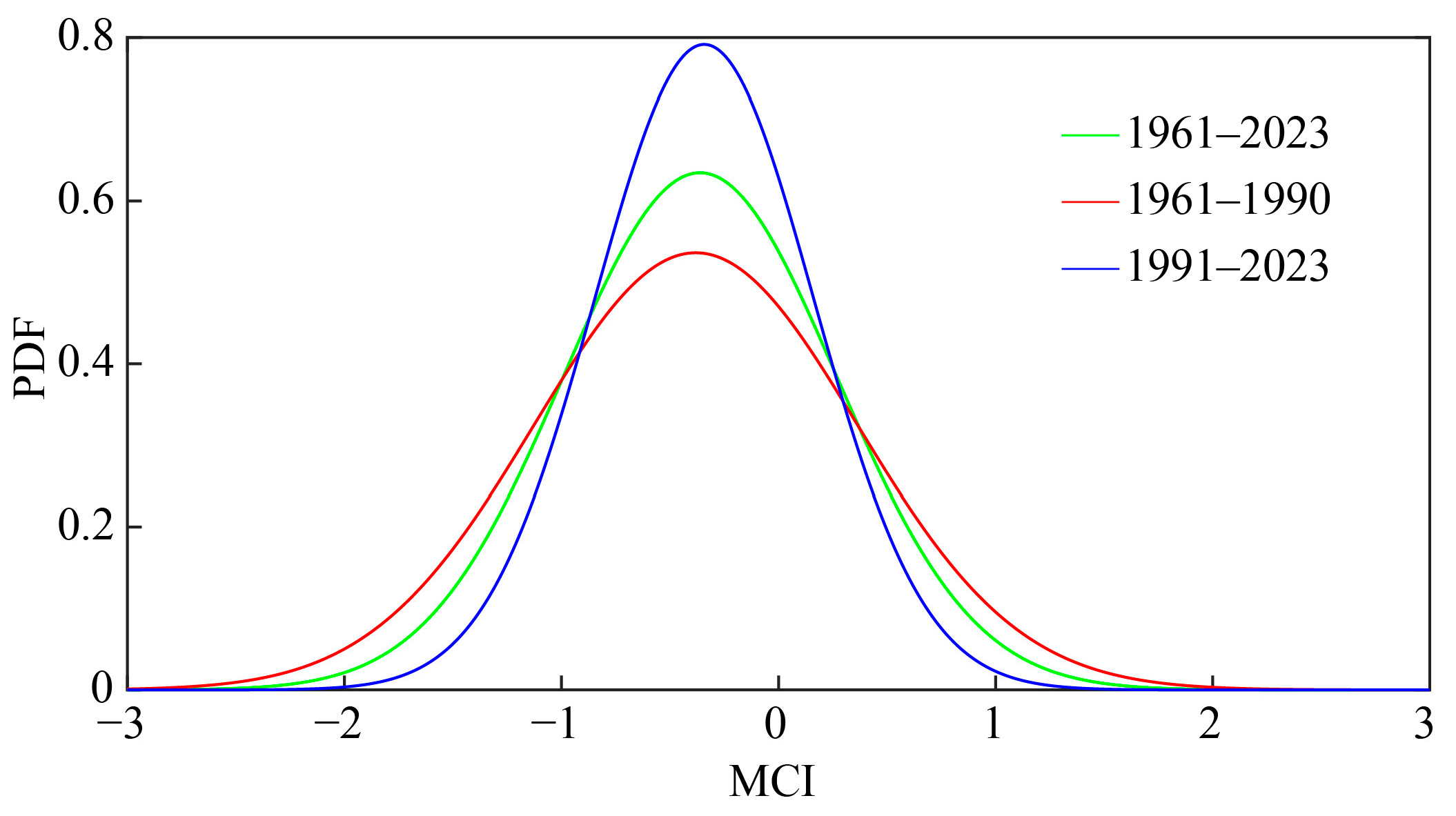
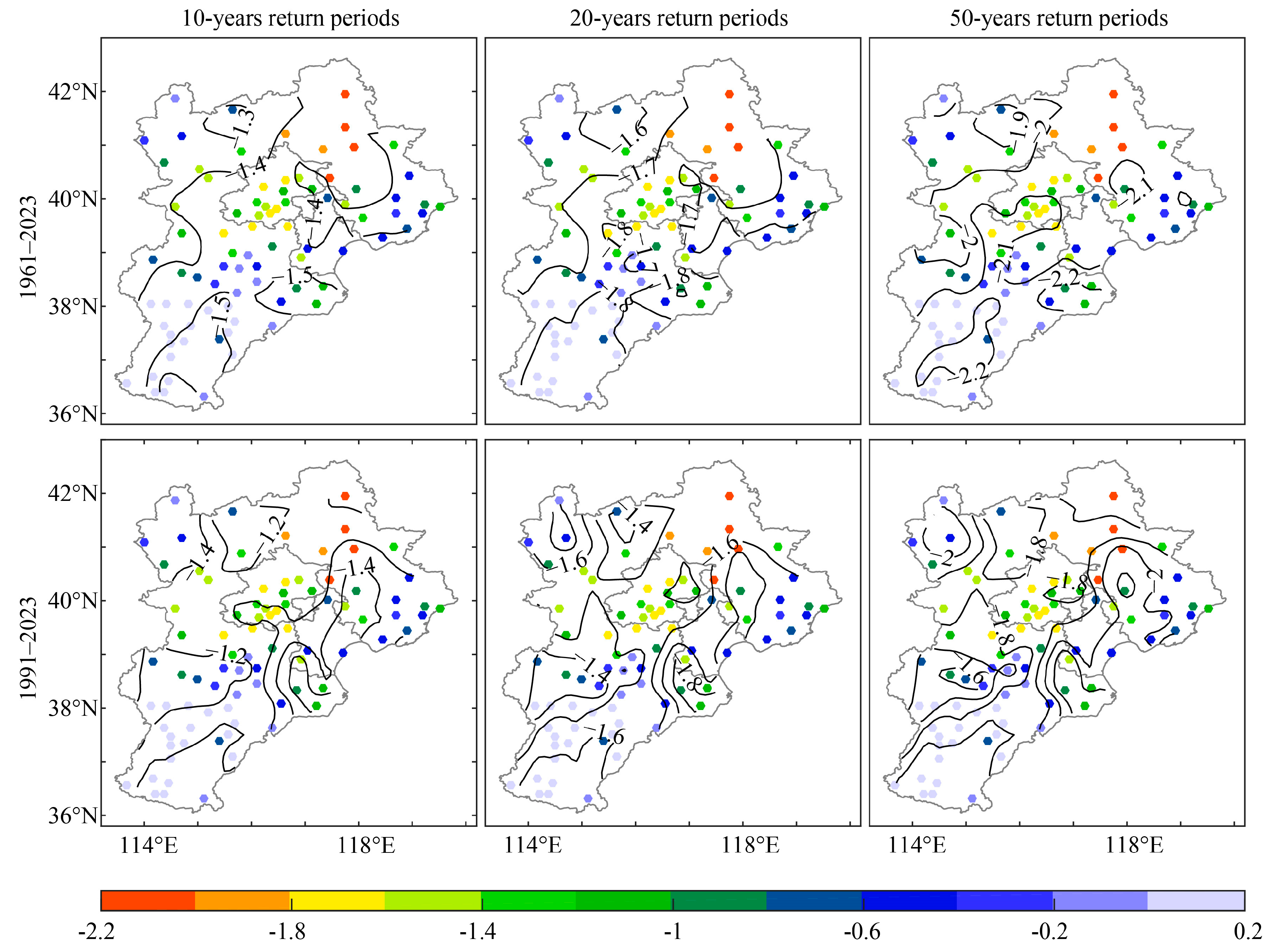
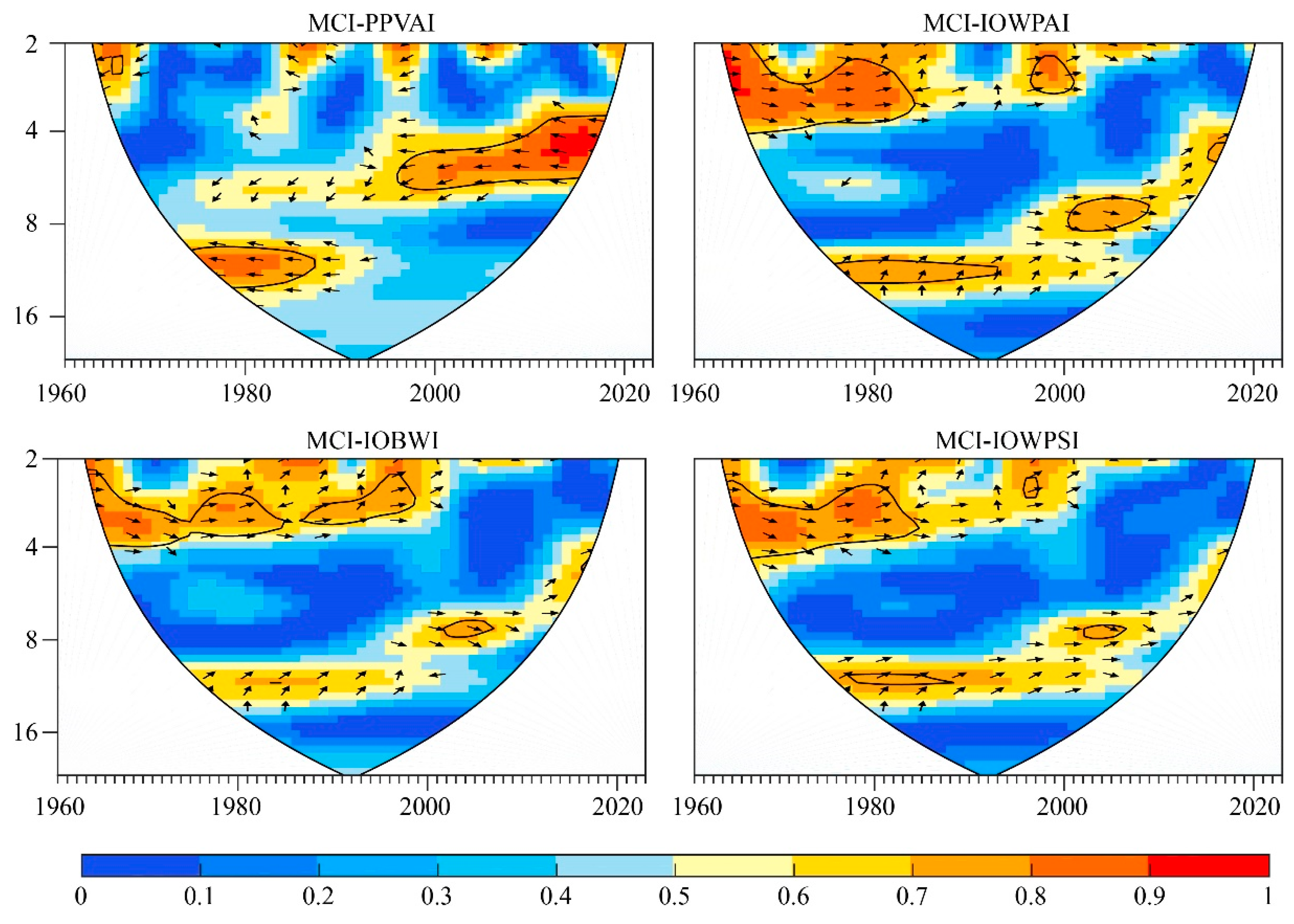
| Month | 1 | 2 | 3 | 4 | 5 | 6 | 7 | 8 | 9 | 10 | 11 | 12 |
|---|---|---|---|---|---|---|---|---|---|---|---|---|
| Ka | 0.4 | 0.8 | 1.0 | 1.2 | 1.2 | 1.2 | 1.2 | 1.0 | 1.0 | 0.8 | 0.6 | 0.4 |
| Atmospheric Circulation/SST Indices | Correlation Coefficient |
|---|---|
| Pacific Polar Vortex Area Index | −0.392 ** |
| NINO B SSTA Index | 0.368 * |
| Indian Ocean Warm Pool Area Index | 0.389 ** |
| Indian Ocean Basin-Wide Index | 0.390 ** |
| Indian Ocean Warm Pool Strength Index | 0.398 ** |
Disclaimer/Publisher’s Note: The statements, opinions and data contained in all publications are solely those of the individual author(s) and contributor(s) and not of MDPI and/or the editor(s). MDPI and/or the editor(s) disclaim responsibility for any injury to people or property resulting from any ideas, methods, instructions or products referred to in the content. |
© 2023 by the authors. Licensee MDPI, Basel, Switzerland. This article is an open access article distributed under the terms and conditions of the Creative Commons Attribution (CC BY) license (https://creativecommons.org/licenses/by/4.0/).
Share and Cite
Du, W.; Hao, Z.; Bai, M.; Zhang, L.; Zhang, C.; Wang, Z.; Xing, P. Spatiotemporal Variation in the Meteorological Drought Comprehensive Index in the Beijing–Tianjin–Hebei Region during 1961–2023. Water 2023, 15, 4230. https://doi.org/10.3390/w15244230
Du W, Hao Z, Bai M, Zhang L, Zhang C, Wang Z, Xing P. Spatiotemporal Variation in the Meteorological Drought Comprehensive Index in the Beijing–Tianjin–Hebei Region during 1961–2023. Water. 2023; 15(24):4230. https://doi.org/10.3390/w15244230
Chicago/Turabian StyleDu, Wupeng, Zhixin Hao, Mengxin Bai, Liang Zhang, Chengpeng Zhang, Zirui Wang, and Pei Xing. 2023. "Spatiotemporal Variation in the Meteorological Drought Comprehensive Index in the Beijing–Tianjin–Hebei Region during 1961–2023" Water 15, no. 24: 4230. https://doi.org/10.3390/w15244230
APA StyleDu, W., Hao, Z., Bai, M., Zhang, L., Zhang, C., Wang, Z., & Xing, P. (2023). Spatiotemporal Variation in the Meteorological Drought Comprehensive Index in the Beijing–Tianjin–Hebei Region during 1961–2023. Water, 15(24), 4230. https://doi.org/10.3390/w15244230






